Chart Wizard Dialog
The Chart Wizard helps you to create a page report tab with a chart in it, create a library component with a chart in it, or edit an existing chart in a report. It varies with the data resource type used by the chart: business view or query resource.
Back
Goes back to the previous screen.
Next
Goes to the next screen.
Finish
Finishes creating or editing the chart and closes this wizard.
Cancel
Does not retain changes and closes this wizard.
Help
Displays the help document about this feature.
Chart Wizard - Business View Based
When the wizard is used for creating or editing a chart using a business view, it consists of the following screens: Data, Type, Display, Filter, Layout and Style. The Filter screen is available only when the wizard is used for creating a chart.
Data
The screen lists all the predefined business views in the current catalog. Select the one you want to use for the chart.
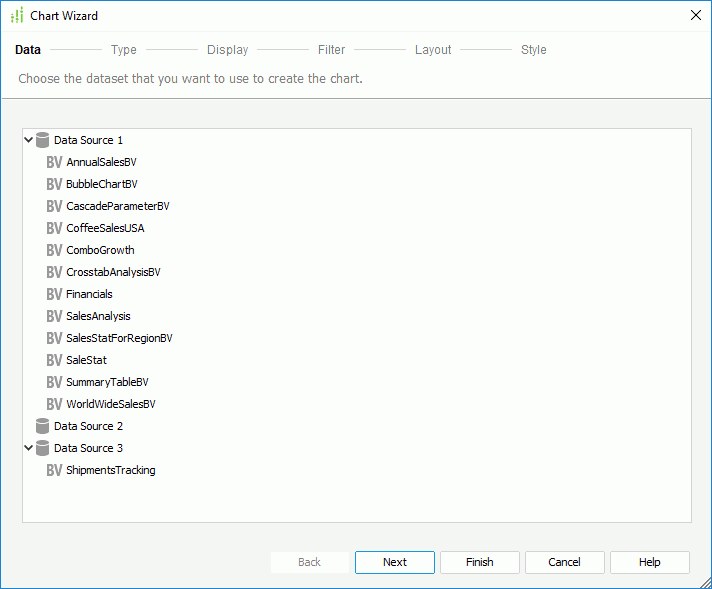
Inherit from the Parent
Specifies to inherit data from the business view used by the parent object. Available only when the chart is in any of the following panels in a banded object in a web report: banded header panel, banded footer panel, group header panel and group footer panel.
Type
Specifies the type of the chart. You can refer to the section Chart Types which describes each of the chart type in detail. When using business view as the chart data source, only the 2-D chart types are supported.
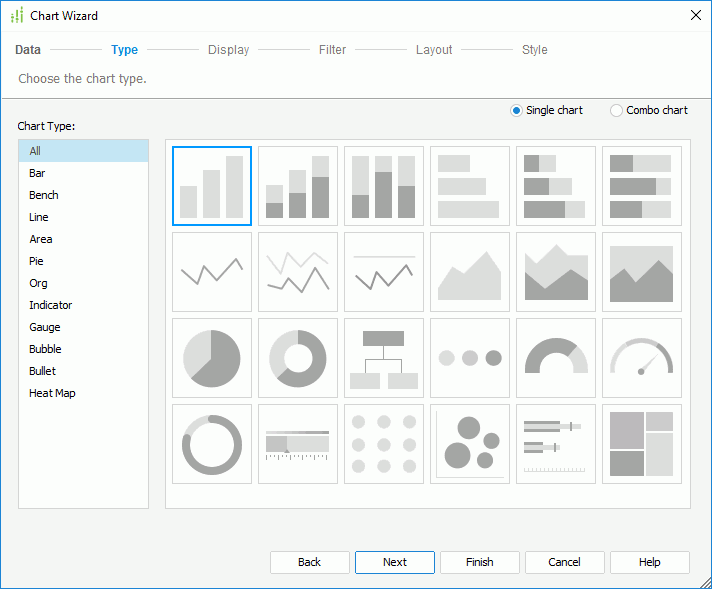
Single chart
Specifies to create a single chart.
- Chart Type
Lists all the chart types that can be used to create a single chart. - Subtype
Lists all the subtypes of the selected chart type. Hover the mouse pointer on a subtype icon and you will see its name.
Combo chart
Specifies to make more than one type use the primary or secondary axis. The types should be featured as combination charts. Two types of data markers are used to represent different data values.
- Chart Type
Lists all the chart types that can be added as a combo chart. - Subtype
Lists all the subtypes of the selected chart type. Hover the mouse pointer on a subtype icon and you will see its name. - Chart Type Groups
Lists all the chart types that are to be used in the combo chart.- Primary Axis
- <Add Combo Type>
Adds a chart type to the primary axis.
- <Add Combo Type>
- Secondary Axis
- <Add Combo Type>
Adds a chart type to the secondary axis.
- <Add Combo Type>
- Primary Axis

Removes the selected chart type from the Chart Type Groups box.
Display
Specifies the data to display on the chart. The screen differs according to the chart type: common chart types, organization chart or heat map.
For common chart types
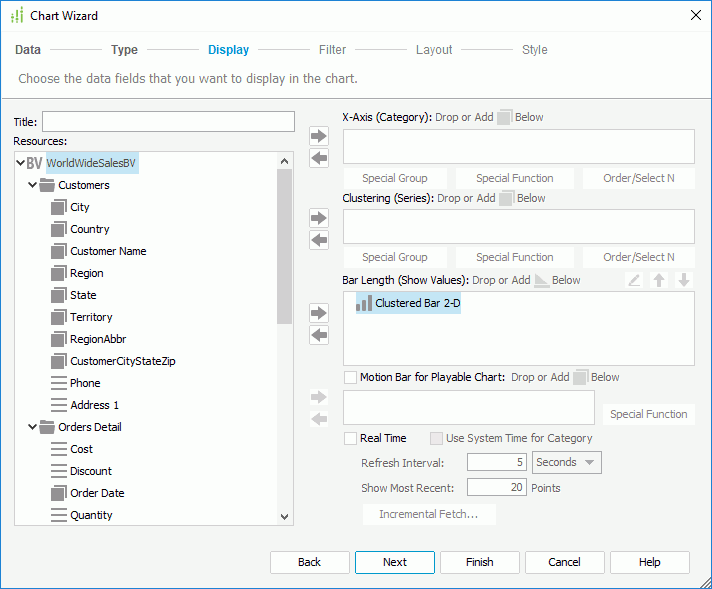
Title
Specifies the title of the chart.
Resources
Lists the resources in and related to the specified business view, which can be used for the chart.

Adds the selected field in the Resources box to the chart axis.

Removes the selected field from the chart.
Category/Series
Lists the field to display on the category/series axis of the chart. For a gauge chart, you can select the Advanced button to show or hide the Category/Series box.
For a real time chart, if no category field is specified, the text Use System Refresh Time will be automatically displayed in the Category box, namely the time at which the chart refreshes itself will be used as the category value; the series axis will be disabled.
- Special Group
Opens the User Defined Group dialog to define how to group information. - Order/Select N
Opens the Category Options dialog or Series Options dialog to specify the sort order of the category or series values and define the number of the category or series values to show on the chart.
Show Values
Lists the values you want to show in the chart.

Opens the Edit Additional Value dialog to edit an additional value. Available only when a constant value or an average value is selected.
Moves the selected value one step up.
Moves the selected value one step down.
Adds a new pair of Y-Axis and Size for the bubble chart.
Removes the selected value from the bubble chart.- X-Axis
Lists the value you want to show on the X axis of the bubble chart. - Y-Axis
Lists the value you want to show on the Y axis of the bubble chart. - Size
Lists the value you want to show as the bubble size.
Motion Bar for Playable Chart
Lists the field used as the motion field. A motion field can only be of the Integer, Date or Time data type. Available to single bar, bench and bubble charts in web reports and library components only.
- Special Function
Opens the Special Function dialog to define special function to the motion field. Available only when the motion field is of the Date data type.
Real Time
Specifies to run the chart in real time mode. Available to single bar, bench, line, and area charts in web reports and library components only.
- Use System Time for Category
Specifies to use the time at which the chart refreshes itself as the category value. - Refresh Interval
Specifies the time interval at which the chart will get data and refresh itself automatically. - Show Most Recent N Points
Specifies the number of points that will be kept for the real time data on the chart. - Incremental Fetch
Opens the Unique Key dialog to configure a unique key for the real time chart.
For organization chart
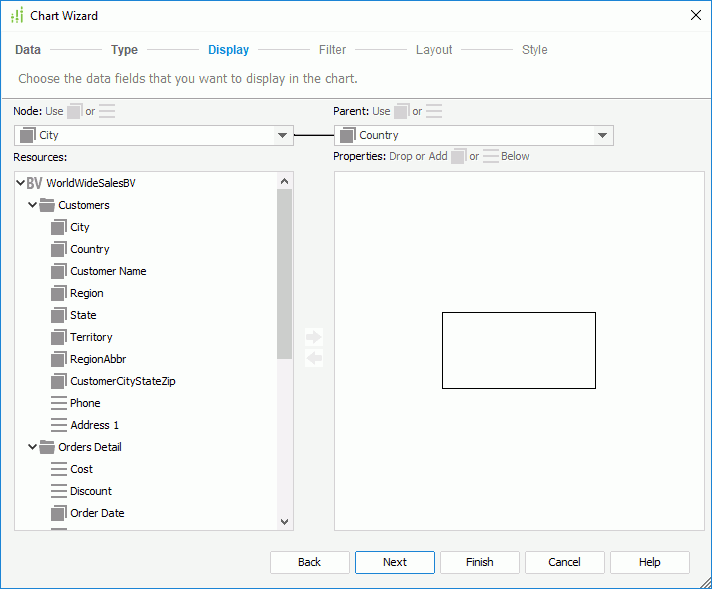
Node
Specifies the field the values of which to display as the nodes in the org chart.
Parent
Specifies the field which shows the "reporting to" relationship among the node field values.
Resources
Lists the resources in and related to the specified business view, which can be added to display in each node in the org chart. You can also add images and labels to the nodes.
Properties
The Properties box presents a node model for specifying the information you want to display in each node in the org chart.
For heat map
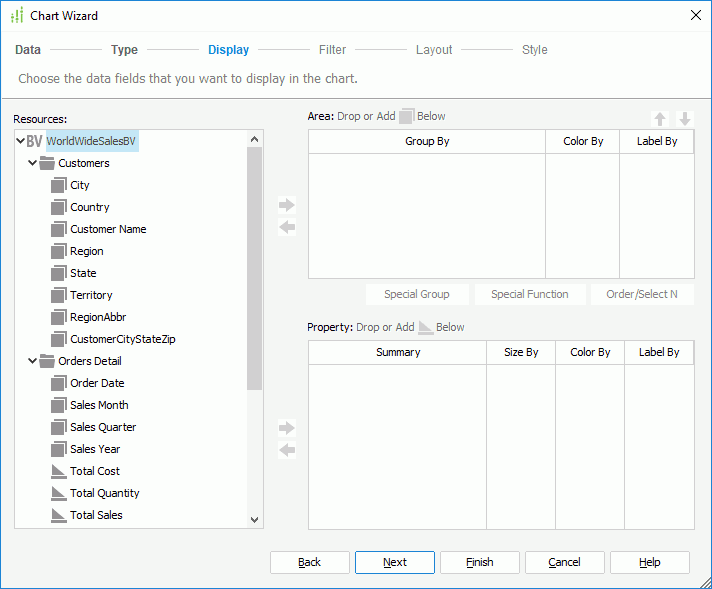
Resources
Lists the resources in and related to the specified business view, which can be used for the heat map.
Area
Lists the groups of the heat map. There should be at least one group.

Moves the selected group one step up.
Moves the selected group one step down.<- Color By
Specifies whether to color by a group. - Label By
Specifies whether to show the values of a group in the innermost rectangles. - Special Group
Opens the User Defined Group dialog to define how to group information. - Order/Select N
Opens the Group Options dialog to specify the sort order of the group values and define the number of the group values to display in the heat map.
Property
Lists the aggregations added to calculate data based on the lowest group of the heat map.
- Size By
Specifies to use the aggregation to determine the size of the rectangles. - Color By
Specifies to use the aggregation to determine the fill color of the rectangles. - Label By
Specifies whether to show the values of an aggregation in the innermost rectangles.
Filter
Specifies to filter data displayed in the chart. This screen is available only when you create a chart, and it contains the same options as those in the Edit Filter dialog.
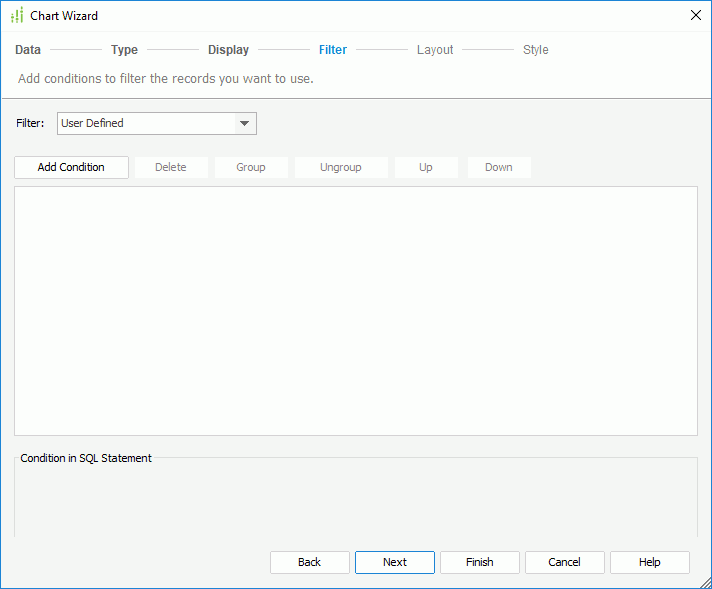
Layout
Specifies the layout of the chart elements. Some layout options may not be available for certain chart types. For details about the options, go here.

Style
Specifies the style of the chart.

Style
Specifies the style of the chart.
- <Custom>
There is no style information on it and it is only used to support reports built with previous versions which did not bind any style or the bound style cannot be found in the style list.
Preview
Displays a diagram illustrating the effect of the selected style on the chart.
Inherit Style
Specifies whether to make the chart take the style of its parent. This options is available only when the chart is inserted in a banded object in a page report.
Page Setup
Opens the Page Setup dialog to specify page properties. Available only when creating a chart in a page report.
Chart Wizard - Query Based
When the wizard is used for creating or editing a chart using a query resource, it consists of the following screens: Data, Type, Display, Filter, Layout and Style. The Filter screen is available only when the wizard is used for creating a chart.
Data
Specifies the dataset for the chart.
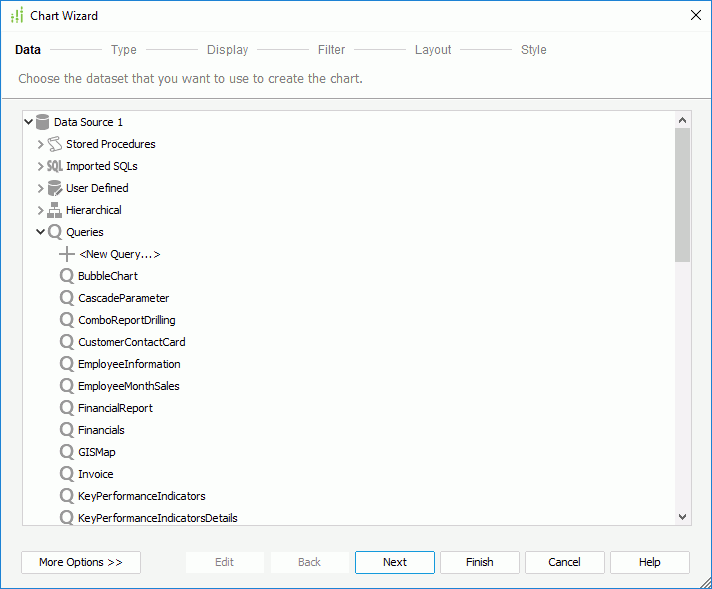
Resource box
Lists the predefined data resources in the current catalog. Select one and a dataset based on it is created automatically for the chart.
More Options/Less Options
Shows or hides the dataset selection panel to choose a dataset for the chart.
- New Dataset
Specifies to create a dataset from the current catalog data resources. When a query is selected, you can select the Edit button to edit the query in the Query Editor. - Existing Dataset
Specifies to use a dataset from the ones existing in the current page report. You can select the Edit button to edit the dataset in the Dataset Editor. - Current Dataset
Specifies to inherit the dataset used by the parent object.
Type
Specifies the type of the chart. You can refer to the section Chart Types which describes each of the chart type in detail.
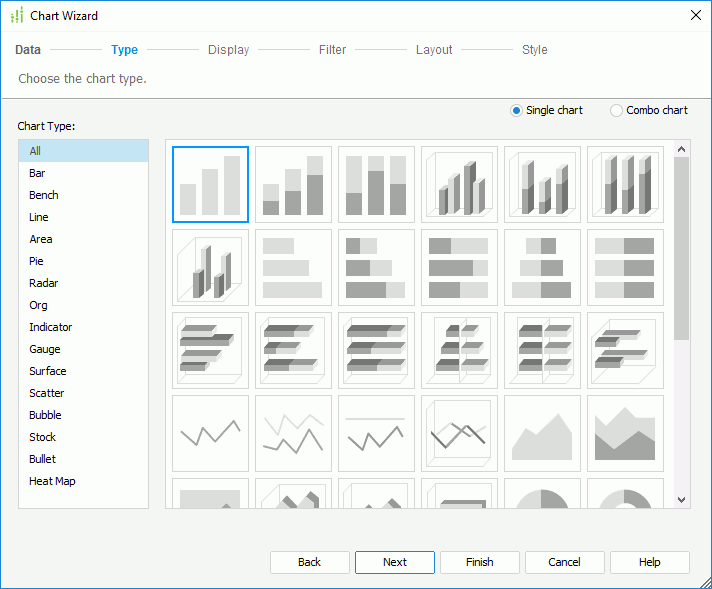
Single chart
Specifies to create a single chart.
- Chart Type
Lists all the chart types that can be used to create a single chart. - Subtype box
Lists all the subtypes of the selected chart type.
Combo chart
Specifies to make more than one type use the primary or secondary axis. The types should be featured as Combination charts. Two types of data markers are used to represent different data values.
- Chart Type
Lists all the chart types that can be added as a combo chart. - Subtypebox
Lists all the subtypes of the selected chart type. - Chart Type Groups
Lists all the chart types that are to be used in the combo chart.- Primary Axis
- <Add Combo Type>
Adds a chart type to the primary axis.
- <Add Combo Type>
- Secondary Axis
- <Add Combo Type>
Adds a chart type to the secondary axis.
- <Add Combo Type>
- Primary Axis

Removes the selected chart type from the Chart Type Groups box.
Display
Specifies the data to display on the chart. The screen differs according to the chart type: common chart types, organization chart or heat map.
For common chart types
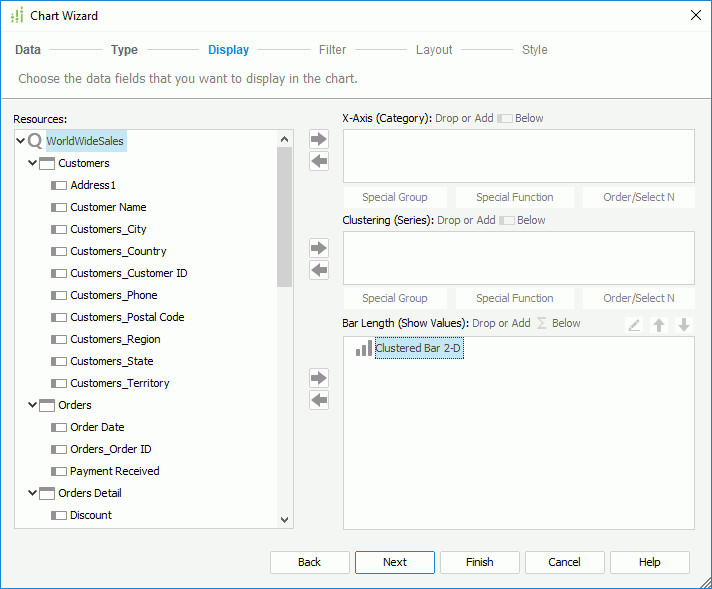
Resources
Lists the data fields in and related to the specified query resource, which can be used for the chart.

Adds the selected field in the Resources box to the chart axis.

Removes the selected field from the chart.

Replaces the selected field in the chart with the specified field in the Resources box.
Category/Series
Lists the field to display on the category/series axis of the chart. For a gauge chart, you can select the Advanced button to show or hide the Category/Series box.
For a real time chart, if no category field is specified, the text Use System Refresh Time will be automatically displayed in the Category box, namely the time at which the chart refreshes itself will be used as the category value; the series axis will be disabled.
- Special Group
Opens the User Defined Group dialog to define how to group information. - Special Function
Opens the Special Function dialog to define special function to the field. - Order/Select N
Opens the Category Options dialog or Series Options dialog to specify the sort order of the category or series values and define the number of the category or series values to show on the chart.
Show Values
Lists the values you want to show in the chart. For a back-to-back bench chart, only one value can be added.

Opens the Edit Additional Value dialog to edit an additional value. Available only when a constant value or an average value is selected in the Show Values box.
Moves the selected value one step up.
Moves the selected value one step down.
Adds a new pair of Y Axis and Radius for the bubble chart.
Removes the selected field from the bubble chart.- X Axis
Lists the value you want to show on the X axis of the bubble chart. - Y Axis
Lists the value you want to show on the Y axis of the bubble chart. - Radius
Lists the value you want to show as the bubble radius. - Left
Lists the value you want to show on the origin left of the value axis on the 2-D back-to-back bench chart. Only one value can be added. - Right
Lists the value you want to show on the origin right of the value axis on the 2-D back-to-back bench chart. Only one value can be added.
Series Values
If the option is selected, you can specify the series values on the origin left/right of the value axis on the back-to-back bench chart manually. Only one of the Left and Right boxes can be edited.
- Left
Lists the series values on the origin left of the value axis. - Right
Lists the series values on the origin right of the value axis. 
Moves the selected value one step up.
Moves the selected value one step down.
Adds a new value line. double-click in it to specify the value.
Removes the selected value line.
Series Conditions
If the option is selected, you can specify the series values on the origin left/right of the value axis on the back-to-back bench chart using condition. Only one of the Left and Right boxes can be edited.
- Left
Lists the condition expression which defines the series values on the origin left of the value axis. - Right
Lists the condition expression which defines the series values on the origin right of the value axis. 
Opens the Edit Conditions dialog to edit the condition which defines the series values on the origin left/right of the value axis.
Removes the added condition.
For organization chart
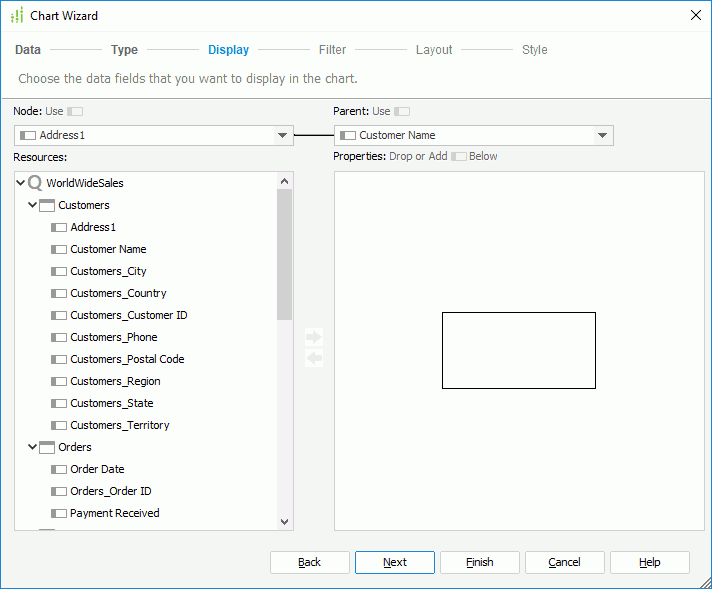
Node
Specifies the field the values of which to display as the nodes in the org chart.
Parent
Specifies the field which shows the "reporting to" relationship among the node field values.
Resources
Lists the resources in and related to the specified query resource, which can be added to display in each node in the org chart. You can also add images and labels to the nodes.
Properties
The Properties box presents a node model for specifying the information you want to display in each node in the org chart.
For heat map
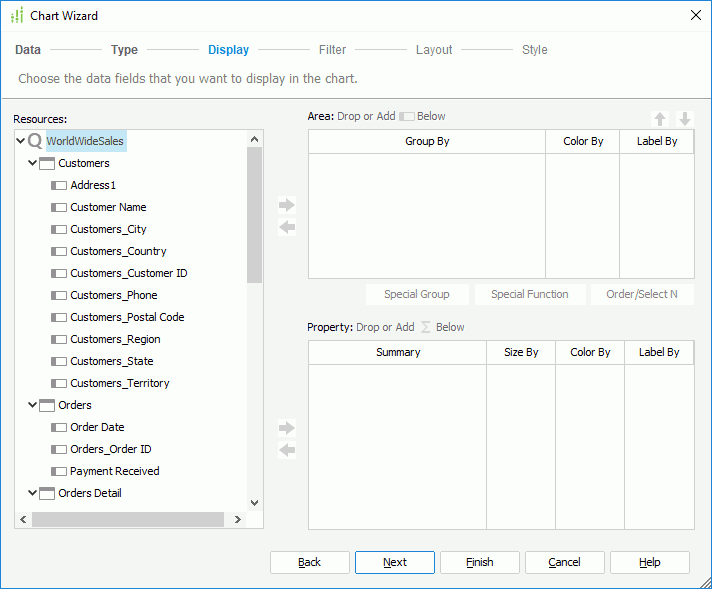
Resources
Lists the resources in and related to the specified query resource, which can be used for the heat map.
Area
Lists the groups of the heat map. There should be at least one group.

Moves the selected group one step up.
Moves the selected group one step down.- Color By
Specifies whether to color by a group. - Label By
Specifies whether to show the values of a group in the innermost rectangles. - Special Group
Opens the User Defined Group dialog to define how to group information. - Special Function
Opens the Special Function dialog to define special function to a group. - Order/Select N
Opens the Group Options dialog to specify the sort order of the group values and define the number of the group values to display in the heat map.
Property
Lists the summaries added to calculate data based on the lowest group of the heat map.
- Size By
Specifies to use the summary to determine the size of the rectangles. - Color By
Specifies to use the summary to determine the fill color of the rectangles. - Label By
Specifies whether to show the values of a summary in the innermost rectangles.
Filter
Specifies to filter data displayed on the chart. This screen is available only when you create a chart, and it contains the same options as those in the Edit Filter dialog.
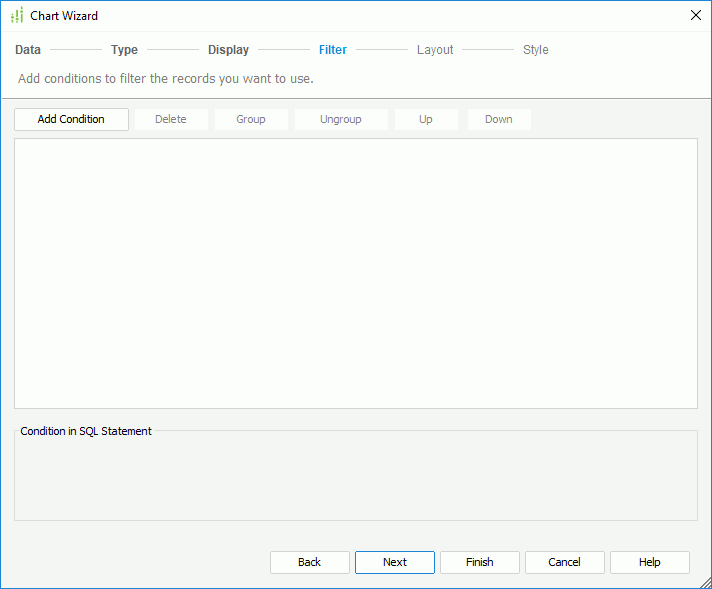
Layout
Specifies the layout of the chart elements. Some layout options may not be available for certain chart types. For details about the options, go here.

Style
Specifies the style of the chart.
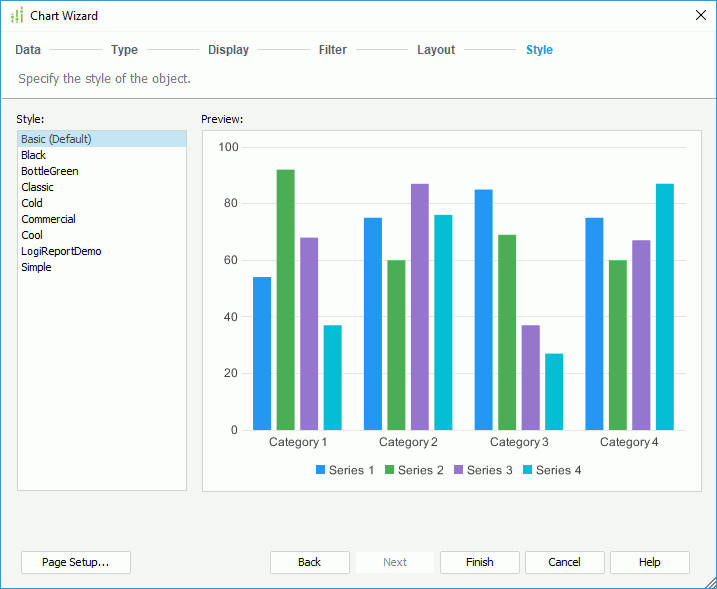
Style
Specifies the style of the chart.
- <Custom>
There is no style information on it and it is only used to support reports built with previous versions which did not bind any style or the bound style cannot be found in the style list.
Preview
Displays a diagram illustrating the effect of the selected style on the chart.
Inherit Style
Specifies whether to make the chart take the style of its parent. This options is available only when you edit a chart and the chart is inserted into a banded object.
Page Setup
Opens the Page Setup dialog to specify page properties. Available only when you create a chart.
 Previous Topic
Previous Topic